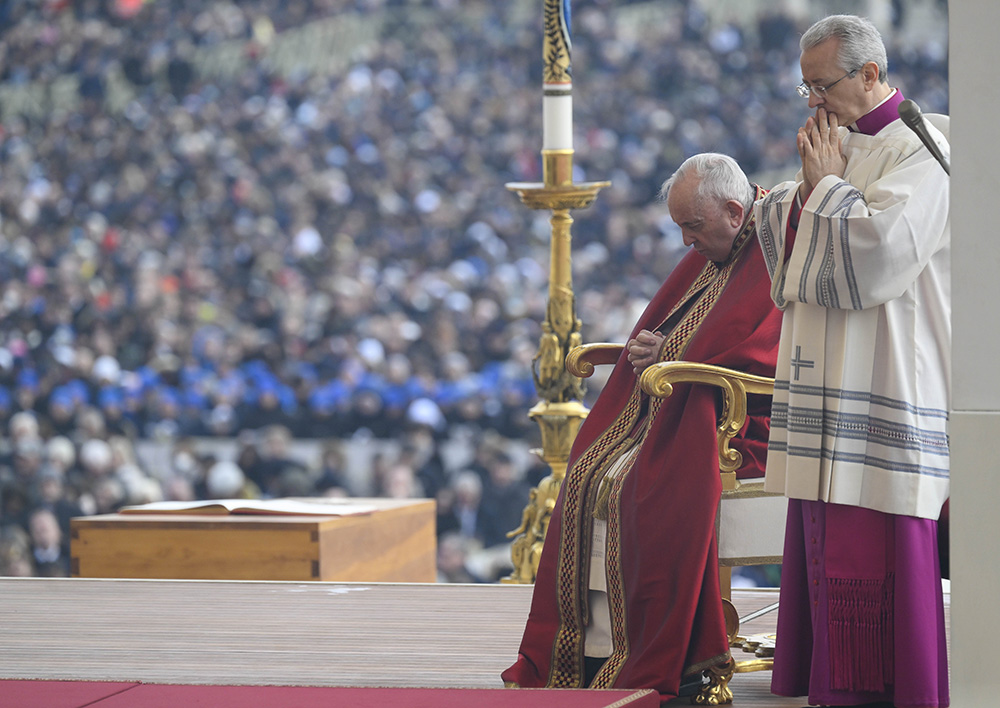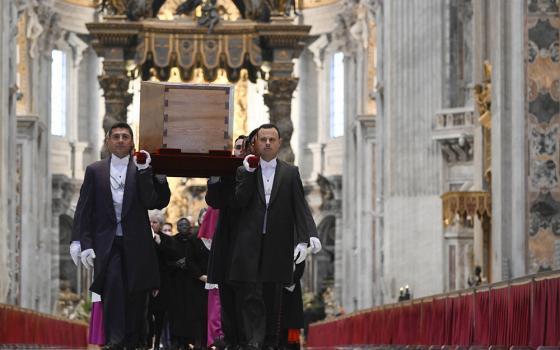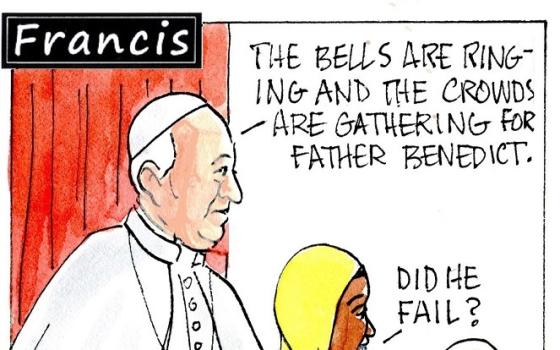
Pallbearers carry the casket of Pope Benedict XVI in St. Peter's Basilica during a procession to St. Peter's Square for the funeral of the late pope at the Vatican Jan. 5. (CNS/Vatican Media)
The funeral of Pope Emeritus Benedict XVI was, of course, celebrated according to the post-Vatican II rite. Some of the prayers were ancient and others, including Eucharistic Prayer 3 itself, consist of ancient texts in a modern combination. The fact that the Mass was in Latin was unremarkable: Most liturgies at the Vatican are in Latin.
The music was polyphony. The Vatican has never warmed to transalpine hymnody, but I was disappointed they found no room for Mozart at the Mass, seeing as Benedict loved his music so much.
The service was, as the late pope had requested, solemn and sober.
In an article at The Catholic Thing posted after Benedict died last Saturday, Fr. Gerald Murray noted Benedict's outreach to those who rejected the Vatican II liturgy. "Benedict's decision to grant greater freedom for the celebration of the traditional Latin Mass was the fruit of his love for the form of the sacred liturgy that he had experienced in his parish church as a boy, and of his heartfelt desire to reconcile the followers of Archbishop Marcel Lefebvre," he writes.
Benedict's desire for reconciliation with the Lefebrvists may have been heartfelt, but it was not reciprocated. And his love of the old rite did not lead him to abandon the post-conciliar rite in his public celebrations of Mass.

Pope Francis presides over the funeral Mass of Pope Benedict XVI in St. Peter's Square at the Vatican Jan. 5. (CNS/Vatican Media)
Murray and others who champion the Tridentine rite, and condemned Pope Francis for restricting access to it, set Francis' decision to restrict the celebration of the old rite against Benedict's decision to increase that access. At face value, who can argue? They overlook the comments of Archbishop J. Augustine DiNoia, who worked closely with then-Cardinal Joseph Ratzinger at the Congregation for the Doctrine of the Faith and later served Pope Benedict at both the doctrinal congregation and the Congregation for Divine Worship.
DiNoia, who is not what you would call a liberal, said Benedict's liberalization of access to the old rite had not had the desired effect.
"The decisive point is there for all to behold: the evident and ongoing betrayal of the intentions of the two pontiffs who permitted the celebration of the 1962 Missal to draw traditionalists back into the unity of the church," DiNoia said. "What the Holy Father is saying is that the [traditional Latin Mass] movement is working for objectives that are precisely contrary to what St. John Paul and Benedict XVI hoped for."
This is the context in which we should hear those who will invoke the memory of the late pope to push an ideological agenda opposing the current one. Ratzinger himself never contradicted his successor's decisions, never set himself in opposition. Would Benedict, if he had not resigned, have come to the same conclusion about the failure of his outreach to the liturgical traditionalists? We can't answer that.

Archbishop Georg Gänswein, private secretary to Pope Benedict, signs a scroll known as a rogito to place with the body of Pope Benedict XVI in his cypress casket in St. Peter's Basilica at the Vatican Jan. 4. In addition to containing his biography, the legal document, written in Latin, also attested to his death and burial. (CNS/Vatican Media)
We should be profoundly suspicious about any comments attributed to the late pope, not least because access to the retired pope, and all information flows, have passed through the hands of his archconservative secretary, Archbishop Georg Gänswein. It is not uncommon that frail, elderly persons become so dependent on their caretakers, they lose the ability to resist the views and interpretations of the caretaker. These past 10 years since his resignation, we do not know how much of Joseph Ratzinger was left.
The Vatican indicated that Benedict approved his funeral plans. Most priests make explicit plans for their funerals. And Benedict's funeral Mass was no exercise in liturgical nostalgia.
Instead, the funeral Mass — so like other pontifical Masses, with the readings and prayers of the faithful spoken in multiple languages — was what liturgy should be, a lived expression of our ancient faith, specifically our ecclesiology. It is 2023 and our liturgy, like our church, expresses the reforms of the Second Vatican Council. The church can still pray in Latin. Also, in Arabic and French and Polish and German.
In this regard, the funeral also should put to rest the misinterpretations attached to Benedict's understanding of reform. No one contests the significance of Benedict's 2005 address to the Curia in which he condemned a "hermeneutic of discontinuity and rupture" in the interpretation of Vatican II and, instead, stated that "true reform" consists in "this combination of continuity and discontinuity."
Advertisement
No talk of the former pope has been more abused. In his New York Times essay after Benedict died, columnist Ross Douthat mentions "continuity" three times, but reform does not merit a single mention. Back in 2015, Galveston-Houston Cardinal Daniel DiNardo, who would serve as president of the U.S. bishops' conference from 2016 to 2019, made a similar mischaracterization (incorrectly attributing the phrase "hermeneutic of continuity" to Benedict) as part of his rude reply to an intervention made by the bishop of San Diego, Robert McElroy, at a U.S. bishops' meeting. McElroy, yesterday, was seated with DiNardo and the other cardinals.
To be sure, Benedict did emphasize points of continuity between the pre- and post-conciliar church in many ways, and such emphasis is essentially conservative. But Francis relies on plenty of pre-conciliar influences, too. Consider the explicit inspiration of Romano Guardini in Fratelli Tutti. Theology, especially the theology of Vatican II, involved both aggiornamento (bringing up to date) and ressourcement (return to the sources), not only one or the other.
The biggest novelty at the Mass yesterday was one directly consequent on a decision by Benedict: The liturgy was presided over by his successor. It must have been intensely personal for Francis to do so, knowing that one day these same rites will be performed for him. Also because he can no longer turn to the man he called a "wise grandfather" for counsel.
Now, Joseph Ratzinger has been called back to his Father's house. His legacy — as a theologian, as a prefect at the Congregation for the Doctrine of the Faith, as pope — will be debated and discussed. The first draft of history is handed from the journalists to the historians who will undertake subsequent drafts. They may be less merciful than the heavenly Father, into whose hands his spirit was commended, but through it all, the faith and the intellect of Joseph Ratzinger will shine through. May he rest in peace.





